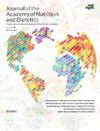Household WIC Benefit Redemption Varies by Participant and Household Characteristics in Southern California
IF 4
2区 医学
Q2 NUTRITION & DIETETICS
Journal of the Academy of Nutrition and Dietetics
Pub Date : 2025-01-27
DOI:10.1016/j.jand.2025.01.014
引用次数: 0
Abstract
Background
The Special Supplemental Nutrition Program for Women, Infants, and Children (WIC) provides benefits redeemable for select healthy foods, aligned with the 2020-2025 Dietary Guidelines for Americans, to support healthy diets among pregnant and postpartum women, and their children to age 5 years, living in low-income households. WIC benefits are often not fully redeemed, limiting nutritional benefits of participation.
Objective
The objective of this study was to assess the associations of WIC participant, caregiver, and household characteristics with WIC food benefit redemption.
Design
This was a longitudinal study using WIC administrative data.
Participants/setting
WIC participants served by a program in Southern California from November 2019 to June 2023 (n = 501 527 certification periods; n = 271 116 individuals) were included in this study.
Main outcome measures
Mean WIC benefit redemption percentage in certification periods in benefit categories (ie, cheese/tofu, eggs, breakfast cereal, legumes, canned fish, fruits and vegetables, infant foods [cereal, fruits and vegetables, meats, contract and therapeutic formula], whole grains/bread, yogurt, whole and reduced-fat milk, and 100% juice) and across all categories, continuous and interval-scaled in 10% increments was measured.
Statistical analysis
Multivariable quantile regression and generalized estimating equation ordinal logistic regression models were used to assess associations of WIC participant, caregiver, and household characteristics with median and interval-scaled redemption percentage, respectively, in each and across all categories.
Results
Redemption ranged from very low (infant meats, 5.4%) to very high (infant formula, 96.2%). Median redemption across all categories was 70.6%. Significantly lower redemption was observed for households of Black, White, and other race/ethnicity-language preference individuals (compared with households of Hispanic English-speaking individuals); households with caregivers with lower educational attainment; and households with at least 1 month without food benefits issued, participating in the Supplemental Nutrition Assistance Program, income <100% of the federal poverty level, ≤5 individuals, or only 1 WIC participant.
Conclusions
WIC benefits are used at different rates by WIC participant, caregiver, and household characteristics. Groups with lower redemption may need additional support in using benefits. Maximizing redemption might help all WIC participants derive the full positive nutritional impact of program participation.
南加州家庭WIC福利兑换因参与者和家庭特征而异。
背景:妇女、婴儿和儿童特殊补充营养计划(WIC)提供可兑换健康食品的福利,与美国膳食指南相一致,以支持生活在低收入家庭的孕妇和产后妇女及其5岁以下子女的健康饮食。WIC的好处往往没有完全兑现,限制了参与的营养益处。目的:本研究的目的是评估WIC参与者、照顾者和家庭特征与WIC食物福利补偿的关系。设计:使用WIC管理数据的前瞻性纵向研究。参与者和环境:2019年11月至2023年6月,南加州一个项目服务的WIC参与者(n=501,527个认证期;N =271,116人)纳入本研究。主要结果测量:认证期间WIC福利类别(奶酪/豆腐;鸡蛋;早餐麦片;豆类;鱼罐头;水果和蔬菜;婴儿食品(谷物、食品、肉类、合同/治疗配方);全麦面包;酸奶;全脂低脂牛奶;100%果汁),并在所有类别中以10%的增量连续和间隔缩放。统计分析:使用多变量分位数回归和广义估计方程有序逻辑回归模型来评估WIC参与者、护理者和家庭特征之间的关联,分别在每个类别和所有类别中,中位数和区间尺度赎回百分比。结果:赎回率从极低(婴儿肉,5.4%)到极高(婴儿配方奶粉,96.2%)不等。所有类别的赎回中位数为70.6%。黑人、白人和其他种族/民族语言偏好个体的家庭赎回率明显较低(与西班牙裔、说英语的个体相比);照顾者受教育程度较低的家庭;结论:根据WIC参与者、照顾者和家庭特征,WIC福利的使用率不同。积分较低的群体在使用福利时可能需要额外的支持。最大化补偿可能有助于所有WIC参与者获得项目参与的全部积极营养影响。
本文章由计算机程序翻译,如有差异,请以英文原文为准。
求助全文
约1分钟内获得全文
求助全文
来源期刊

Journal of the Academy of Nutrition and Dietetics
NUTRITION & DIETETICS-
CiteScore
7.20
自引率
10.40%
发文量
649
审稿时长
68 days
期刊介绍:
The Journal of the Academy of Nutrition and Dietetics is the premier source for the practice and science of food, nutrition, and dietetics. The monthly, peer-reviewed journal presents original articles prepared by scholars and practitioners and is the most widely read professional publication in the field. The Journal focuses on advancing professional knowledge across the range of research and practice issues such as: nutritional science, medical nutrition therapy, public health nutrition, food science and biotechnology, foodservice systems, leadership and management, and dietetics education.
 求助内容:
求助内容: 应助结果提醒方式:
应助结果提醒方式:


